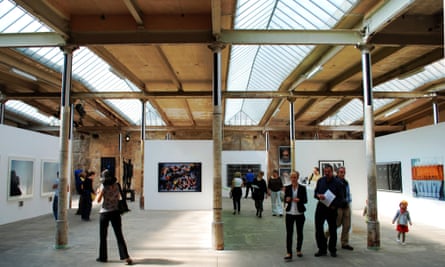In November 1989, three days before the fall of the Berlin Wall, East German television screened a documentary called Ist Leipzig noch zu retten
(Is there hope for Leipzig?). The revelations were explosive: contrary to what the GDR regime had been claiming, the film showed Saxony’s largest city crumbling to pieces. Saving it would require so much time and money, some of the architects interviewed reckoned, that it would make be more sense to flatten the historic quarters altogether.
Twenty-five years later, the people of Leipzig have different concerns. Gushing reports of the city’s thriving creative scene, green spaces and quality of living have earned the place the nickname Hypezig, and some locals fear its reputation as “the better Berlin” may attract private investors, and drive up property prices.
Plagwitz, the western district whose housing stock was so bad in 1989 that Leipzig’s chief architect said “it would be irresponsible to have people continue to live here”, illustrates the city’s transformation. Once a soot-covered industrial suburb dotted with the chimneys of metalwork shops, it has cleaned up its act but not lost its crooked charm. Buildings on the main thoroughfare, Karl-Heine-Strasse – it’s named after the 19th-century industrialist who put the district on the map – have almost all been renovated, but without losing their sense of history. Some of them may now house galleries and ice-cream parlours that sell strawberry and lavender sorbet, but family businesses such as Schicketanz butchers and Seidel’s bakery will keep the area grounded. At Meins bar and cafe, a student favourite, they cook old-fashioned family recipes such as eggs in mustard sauce, and invite guests request their favourite “granny food”.
As part of a project started in 2006, houses on Karl-Heine Strasse have been fitted with neon signs spelling out abstract qualities associated with what takes place inside – “comfort”, “effort”, “lust”, and so on. To find out more, try a three-hour walking tour with Ina Thyrolf of Eat The World that dives deep into the area’s cultural and culinary secrets.
Plagwitz’s charm is different from Berlin’s, where the numerous side-street cafes can lend the capital a sleepy, villagey feel. Leipzig, though smaller, feels busier: social life takes place along the city’s main arteries. Its art scene, too, is more focused, more work-orientated, with an aesthetic – socialist realism meets pop art – which feels like it belongs nowhere else.

The Baumwollspinnerei on Spinnereistrasse off the western end of Karl-Heine Strasse is a former cotton mill now home to over 120 artists’ studios and the engine of Plagwitz’s revival: walking along its cobbled streets on a balmy late summer afternoon, one sees surprisingly few artists basking in the sunshine. Most of them are in their studios, getting work done.
On Fridays and Saturdays, you can take a guided tour of the studios (€10pp, non-German speakers should call in advance), and even stay in some of the studios – at €65-€85 a night, they are cheaper than hotels in the area. Next year, as Leipzig celebrates its 1,000th birthday, the Spinnerei also celebrates the tenth anniversary of its Rundgänge, the open days held in January, May and September.
The artists, such as Maria and Vlado Ondrej, accept that Plagwitz is no longer a secret. After all, they need people to buy their work, say the couple, who have been making prints in the Spinnerei since 1993. “If we want to get on with our work we just close our doors”, says Vlado. “The good thing about working in a factory is that the doors are really solid.”

Comments (…)
Sign in or create your Guardian account to join the discussion